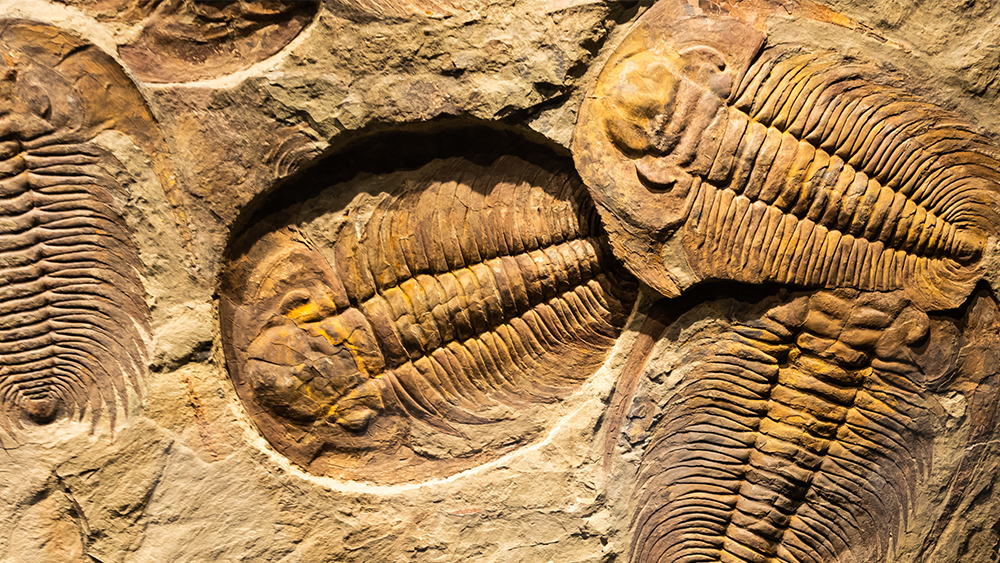One of the more amazing animals of God’s creation was the trilobite. This strange-looking creature was an ocean bottom-dwelling animal that remains one of the best-known Cambrian fossils. Many types of trilobites are found in early Flood sediments, with some found in layers as high as the Permian System.
God designed trilobites similar to other arthropods:
a body divided into three parts—head, chest, and tail, the former two consisting of as many as thirty segments. It had a pair of legs for every pleural groove and another three pairs for the head. Most dramatic of all were the compound eyes found on even some of the very early trilobites–eyes that afforded these not so primitive animals a 360-degree field of vision.1
Additionally,
There are at least 56 families of trilobites composed of about 3,900 species, “about 70% of the known Cambrian species of metazoans.” Their size normally ranges from one to four inches, but some fossils are as much as 39 inches long. But small or large, they suddenly appear as 100 percent trilobites with no indication of gradual evolution.2
Clearly, trilobites have always been trilobites since their creation thousands of years ago.
Evolutionists have been asking, what killed these well-designed animals? The question is even stated in this article: “But about 252 million years ago, trilobites disappeared from the fossil record. What finally wiped out this class of resilient bottom dwellers?”3
The evolution-based article went on to describe a “most devastating mass extinction event.”
However, extinction “events” are not real. What scientists call extinction events are merely the last occurrence of several types of organisms in the Flood rocks. Many organisms seemingly disappeared at about the same time as the trilobites, as the Flood waters continued to rise, inundating completely new ecosystems and different environments. This creates the appearance of a sudden change in fossils while burying new types of organisms in the process.
Interestingly, for creationists, a Flood of catastrophic proportions is also a mass extinction event. In addition, the Genesis Flood also explains the world’s great fossil graveyards.
Over 95 percent of all fossils are marine creatures. They died and are fossilized by the trillions. Many are buried in great fossil graveyards, tightly packed together, choked with sediments, buried before they had time to decay. Obviously, they didn’t live in the environment in which they died. They were transported by rapidly moving water and then buried in sedimentary deposits.4
Since trilobites are ocean bottom-dwelling animals, they would have been buried first and in the earliest rocks during the Flood about 4,500 years ago.5,6
It should be emphasized that most creationists have always appealed to the Flood to explain the demise of the dinosaurs (as well as all other terrestrial animals and birds) and the formation of the majority of sedimentary rock layers throughout the world (e.g. Grand Canyon).7 Conversely, evolutionists—up until recently—have embraced the doctrine of slow and gradual uniformitarianism. Now, most evolutionists look to the Chicxulub impact/Alvarez hypothesis to describe dinosaur extinction “66 million years ago.” In other words, after many decades of denigrating the Genesis flood, they now appeal to a world-wide extinction event every bit as catastrophic and violent as the Flood—if not more so.
Furthermore, evolutionists claim there are numerous mass extinction events. However, the cause for each is hard to study, less specific, and less clear.
The second mass extinction, the Late Devonian, hit the trilobites starting around 375 million years ago. The Late Devonian extinction was slower and the cause less specific than the one before and after it. It's harder to study because it happened over a long interval, [Melanie Hopkins, an associate curator of paleontology at the American Museum of Natural History in New York City] said, but it likely led to a slowing of evolution and diversification. Though the direct cause is less clear, the effect of the second extinction on the trilobites was profound.3
The best answer is simply that He designed the incredible trilobite–in all its variations–and that it was suddenly caught up and buried by the great Flood described in Genesis.
References
- Meyer, S. 2013. Darwin’s Doubt. Harper One. 10.
- Sherwin, F. 2013. God’s Amazing Invertebrates: The Missing Links Are Still Missing. Acts & Facts. 42 (2): 12-15.
- Coffey, D. Why did trilobites go extinct? Livescience. Posted on livescience.com November 15, 2020, accessed June 5, 2023.
- Morris, J. 2011. Fish in the Flood. Acts & Facts. 40 (5): 16.
- Clarey, T. 2020. Carved in Stone: A New Flood Model. Acts & Facts. 49 (5).
- Clarey, T. 2014. Trilobites: Sudden Appearance and Rapid Burial. Acts & Facts. 43 (2). 10.
- Morris, J. 2009. Sedimentary Structure Shows a Young Earth. Acts & Facts. 38 (7): 15.
* Dr. Sherwin is science news writer at the Institute for Creation Research. He earned an M.A. in zoology from the University of Northern Colorado and received an Honorary Doctorate of Science from Pensacola Christian College.





















